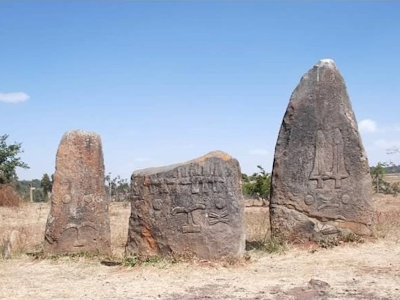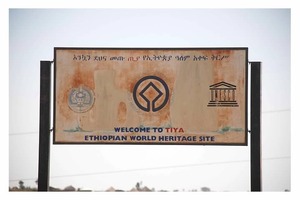Tiya

Tiya is an archaeological site renowned for its decorated stelae.
These megaliths are marking a large, prehistoric burial complex of an ancient Ethiopian culture. The standing stones are decorated with symbols, some of them sword-like. These two groups of in total 36 stelae date from between the 10th and 15th centuries AD. They are seen as the best examples of a larger tradition of megalithic pillar sites in the region.
Community Perspective: “Enigmatic”, but Solivagant and Astraftis made an effort to interpret the site. Tiya can be visited on a (long) day trip from Addis Abeba. It is a very small site and a visit is likely to be underwhelming to the general audience.
Map of Tiya
Community Reviews
Astraftis

Tiya was one of the first things I saw of Ethiopia, on a morning of August in 2015, after having been picked up by our drivers/guides from the airport together with my small group at dawn, after little or no sleep (it seems that my experience was quite similar to Juha's). Our final destination was the south and the Omo valley, but on that first day the guides had planned to bring us (also) here on the way to our first stop-over in Hawassa; from this and the fact that a troupe of a local television was there to take an interview with us, I got the impression that they were trying to promote the site somehow.
Anyway, I didn't know anything of Tiya, but, despite a general sense of negligence (the stelae were in a fenced field with unmown grass, and at the time the only nearby building was a toilet shack), we (as the only visitors) were very well received and I found that the local guide was well prepared and passionate, and could explain us what is known and speculated about these stelae in a good English. Neither is to be taken for granted, and I greatly appreciated it. This surely improved my understanding of the site.
I noticed that my travel companions were disappointed by the visit. I have to admit that the site is not a spectacular one, albeit its position is amidst a very beautiful countryside, dotted with huts and trees. In fact, you get to see some tight rows of stone stelae of varying size, height and conservation status, with etched symbols that are repeated over and over. They seem to represent male and female, social (e.g. weapons) and religious attributes and more, but the culture to which they belong is unknown. Now, I think that the disappointment might have originated from unmet expectations: as Europeans, we are used to such monuments, we are not impressed by something so "common". But, as far as I understood, this is actually one of the few scattered (known & accessible) archaeological sites in Sub-Saharan Africa, and among the oldest artifacts one will get to see here. Beyond that, these stelae are testimony to one of many ancient migrations that reached Eastern Africa, and that even until today shape the demography of Ethiopia (just consider the ethnical and social tensions between Amhara and Oromo). On a more personal note, I am always fascinated by this sort of cryptic glyphic artworks, wondering what cultural system might have left it, so I liked Tiya.
I don't think there is a sensible way to reach Tiya other than with a private means of transportation. It is not very near to Addis Abeba, but it will be easy to include in any tour that passes through this region e.g. towards the south, and it can be a nice stop. Just take it for what it is; as with many other archaeological sites, its true interest needs some introduction of sort to be enjoyed. Also, it would be curious to know how much has been achieved in the field of studies on African antiquities since 1980, the year of Tiya's nomination, and if new connections have appeared with other sites.
Juha Sjoeblom

Site visited April 2015. The small and puzzling site of Tiya left me with mixed feelings. For me it was the first taste of Ethiopia and as such it was an exciting journey. But if you are not a WHS or cultural history enthusiast the experience could be underwhelming.
Tiya is an early inscription from 1980. Although it is quite near Addis Ababa it is not very easy place to reach. In theory there should be some bus connection but I wouldn’t count on it. In practice the only reasonable way to visit Tiya is to hire a car and a driver which I did via local travel agency.
I had arrived in Ethiopia just a few hours earlier. In the morning, after two hours of sleep, the driver picked me up from my hotel. The journey in the countryside south of Addis Ababa was fascinating as we stopped along the route to admire nice views and meet some shepherds of Oromo people.
After three hours we arrived in the site of Tiya. There was someone who collected a small entrance fee and also a souvenir seller in a small hut. Besides them I was the only visitor.
The site is very small with 36 steles in three clusters. The steles are up to two meters in height and some of them lie on the ground. Almost all the stones have engravings which include swords, circles, false banana trees and some unidentified symbols. There have been different hypotheses about the reason for their existence. Bones have been discovered beneath the steles which might indicate that Tiya is a burial site and the steles are the grave markers of some lost civilization.
My driver told that in this area there are almost two hundred same kind of steles. He said that the plan is to gather more stones from the surrounding area and to bring them to this site because there the stones are better taken care of. I don’t know if that is true. Some renovations have been made just before my visit as they had paved the footpaths around the steles. There was also a new museum being built at the time my visit.
Usually the tours to Tiya include also visits to Melka Kunture archaeological site and Adadi Maryam church because they are located along the route. Adadi Maryam is the same kind of rock-hewn church than the ones in Lalibela but in much more smaller scale. Unfortunately Melka Kunture site was closed at the time of my visit.
Ethiopia is full of remarkable World Heritage Sites but Tiya is not quite in the same class. Spectacular is not the right word for this site. Visiting it is of importance for WHS enthusiasts, like me, but is it as itself worth a long and costly journey - I don’t know. I’m happy that I visited this strange and remote site but I can’t recommend it for everyone.
kedrela mohammed
it was nice to be there.all the stone and its message is amasing. the site is vere closer to the main road. eventhough it is on of among the world heritage, it's future existance is questionable. the is no facilities for turists or visitors. the whole site is run by only three person. as a studend of cultural related things i felt unhappy about the existing situation. as a resonssible generation we are expected alot to preserve and forwarded it to the future or coming generation
Solivagant

A word commonly used regarding Tiya (including in the UNESCO documentation itself) is “Enigmatic”. Despite its inscription as long ago as 1980 remarkably little is known about the c35 strangely carved standing stones situated in a 200 metre square site 85 kms outside Addis Ababa. Which group of people created them? What is the meaning of the carvings? When were they erected? All is vague.
We were told that a number of bodies had been found which had been carbon dated at between the 12th and 14th centuries. All appeared to have been warriors killed in battle. The layout of the stones certainly gives the impression of a row of head stones and graves beyond them. Many are carved with what are clearly swords but other motifs are less clear – a suggestion for a commonly occurring “fountain-like” shape is that it is a “false banana” tree – a significant plant in the drier areas of Ethiopia, providing all year round flour and leaves for houses etc. One flat stone is carved with a figure but there are no others, no script and no recognisable religious symbols from either Christianity or Islam (the 2 main religions of the region across the relevant period).
If you have a spare day in Addis and transport (you might just about make it return in a day on public transport on the road to Butajira but I wouldn’t bank on it) it is worth taking in this WHS (there is also a nice early hominid site and excellent new museum a few kms earlier at Melka Kunture). But the “fame” of inscription appears to have had little effect in the small village of Tiya nor on the site itself which just has a hut with a couple of guards also no doubt guarding each other for the entrance fees (30 birr for foreigners)! The prospects all around are totally rural and the site itself is covered by long grass. There are no signs and no literature. And almost no visitors!
Indeed one suspects that, if the site were proposed today, it would probably not get past the ever tougher inspections of ICOMOS. Interesting certainly, but of more than local/regional significance? Unlikely? In 1980 the barrier was much lower and this was 1 of 4 Ethiopian sites inscribed that year. Nevertheless we enjoyed both the visit and the drive to and from.
Community Rating
Site Info
- Full Name
- Tiya
- Unesco ID
- 12
- Country
- Ethiopia
- Inscribed
- 1980
- Type
- Cultural
- Criteria
-
1 4
- Categories
- Archaeological site - Prehistoric
- Link
- By ID
Site History
1980 Inscribed
1979 Deferred
Bureau meeting - info requested in 78 still not in place
1978 Deferred
Bureau meeting - info requested
Site Links
Unesco Website
Official Website
Related
Connections
The site has 8 connections
Constructions
History
Human Activity
Timeline
WHS Names
World Heritage Process
Visitors
52 Community Members have visited.
The Plaque
 (external source)
(external source) (photo by Michael Novins)
(photo by Michael Novins)